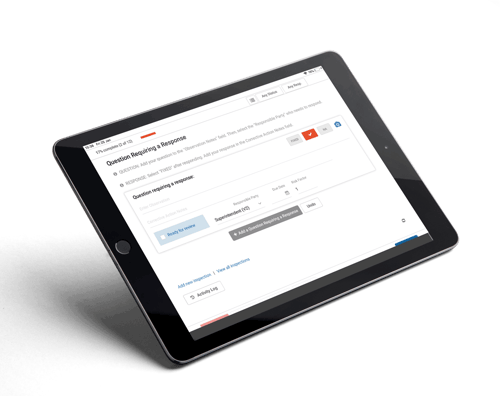
Field and office communication can make or break a construction company. Whether it’s take-off counts, blue print errors, subcontractor performance, or schedule delays, this information must make its way from the jobsite to the back office in a timely, efficient manner. Then back again to the jobsite with updates and resolutions.
Unfortunately, this two-way line of communication often breaks down and leads to a lot of finger pointing within construction companies.
Builders who are overcoming this hurdle are using Inspection Software on mobile devices as a communications system – on autopilot.
Because the Inspection Software is made up of a series of checklists, it essentially communicates a “question” the Construction and/or Project Managers must answer, who then returns the “result.”
An Inspection process in the form of checklists are one of the simplest forms of field and office communications, as they are easily digestible for Construction Managers who are busy traveling to various job sites, meeting with subcontractors and supplier, and overseeing construction.
Checklists also use simple, actionable language, and are custom-tailored for specific activities. And, while some builders may look at an inspection checklist as merely a record of task completion, the information collected is essential to field and office teams as well as many internal departments to make improvements.
For example, the Purchasing Department often needs take-off counts. With well-implemented Inspection Software in place, checklists and inspections can automatically prompt the Construction and Project Manager to enter shortages and overages into the program. Then Purchasing can pull this data as needed, without having to send an email request to the Construction Team, followed by multiple reminder emails.
Utilizing the system that's already in place can allow back office personnel to connect with Construction Managers who do not report to one office every day and stay up-to-date with progress and perhaps important project documents.
Another common communications issue is a lack of feedback (positive or negative) from the Construction Manager. This can refer to a wide range of issues such as:
- Materials
- Scheduling
- Subcontractor crews
- Blue prints.
Again, Inspection Software provides a platform for the Construction Manager to enter problems and observations and it can bridge communication between field and office teams. If blue print errors are regularly input into a program while the project is under construction, the architect can pull this data and make corrections before the floor plan is built again and avoid costly mistakes. There's no need to meet one-on-one, which often either never happens or happens too late to make a difference.
And, since the Inspection Software provides two-way communication opportunities, the architect can insert specific checklists and inspections for newly released plans. This allows the Construction Manager to identify problems with a new floor plan or design early on and avoid expensive work-arounds, call backs and warranty issues down the road.
The key to making this work though is consistency. The Inspection Software won’t work with just one or a couple of Construction Managers participating. It won’t work if checklists and inspections are performed randomly. It’s all or nothing, else Field to Back Office communication will continue to break down.
If the Back Office personnel can’t pull the needed data from the system for all jobs across the board, and must still send emails, make phone calls, and continue to wait, then improvement will continue to wallow. If Construction Managers aren’t seeing corrected budgets and plans, they will stop taking the time to provide feedback. Nothing will change.
Efficient construction communication is essential for everything from your inspection process to the execution of projects.
Today’s builder can’t afford to underestimate the power of an automated communication system between the jobsite and the back office. Inspection Software inherently provides the source to connect the many roles within the construction company. And while traditional builders are distracted with inaccurate take-off counts and blue print errors, the organized builder is reducing cycle time and wasted costs with a synchronized team in place, all using the software for improved communication.
the software for improved communication. Stay ahead of your competitors in the construction industry and avoid communication failures with FTQ360's software.

